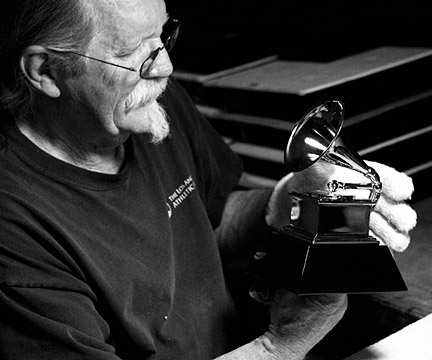December 14, 2010
FOR IMMEDIATE RELEASE
NEW YORK, NY—Manufacturers turn to copper alloys for ease and tradition
For athletes and entertainers alike, a successful career is measured by more than money and fame. Awards won and trophies collected play an important part in the making of a legacy. From the kid in Little League to the Broadway star, everyone loves receiving a trophy as a symbol of their accomplishments.
As the physical embodiment of success the value of an award is extrinsic - no one is melting down their Oscar® to sell for scrap. But one characteristic that most awards have in common is their heft; weight lends a certain gravitas to a trophy. Designers and manufacturers of awards have long used the copper alloys, brass and bronze to give their work the required look and feel. Bronze in particular, is seen as a symbol of tradition and recognition. In ancient Greece; bronze vessels were given out as prizes in athletic competitions, and in the modern era the International Olympic Committee awards the bronze medal.
When the American Theatre Wing decided to upgrade the Tony Award in 2010, they made the trophy larger and heavier in order to give it a more substantial look and feel. The base of the award, supports a brass and bronze medallion with nickel plating featuring the masks of tragedy and comedy on one side, and a relief of the award's namesake, Antoinette Perry, on the other. It was made a few inches taller. This added a physical stature to the trophy that reflected the prestige of the award.

Photo courtesy of John Billings, Billings Artworks.
Weight isn't the only consideration in choosing to work with bronze; its ease of fabrication allows sculptors to include the small design details that make certain trophies iconic. The Grammy Award is one of America's most prestigious awards in entertainment; it is distributed annually by the Recoding Academy® to musicians and performers who excel in categories that span the musical spectrum. The award is famously shaped like an old fashioned gramophone, but the tone arm, or needle of the award had a history of breaking off. In the early 1990s, the award was cast in bronze and made larger. By doing so, the tone arm was strengthened and increased the weight to a little more than four pounds.
"The tone arm was always a problem in that it was so thin and fragile and had a definite weak spot where it would inevitably break," said John Billings, of Billings Artworks, who makes both the Grammy Award and the John R. Wooden Award for the most outstanding collegiate basketball player during an NCAA season. "My approach was to redesign the weak spot by getting rid of the filigree and make it about five times thicker."
Billings said that when the new Grammys first came out, previous winners could trade their older versions for the new ones. "Quincy Jones, a 27-time Grammy winner, traded in all of his," said Billings, adding that Jones was one of the first to do so.
In the world of sports, both the Heisman Trophy® and the John R. Wooden Award Trophy mark achievement in collegiate football and basketball, respectively. They are both notable for their accuracy of detail and the sense of movement they capture. Bronze is used for both because it is a malleable material that is well suited to intricate work.
The Heisman is famous for its depiction of a football player running with the ball, while the John R. Wooden Award Trophy features the five position players on the basketball court. Both trophies emphasize the athletes' uniforms, from the folds of fabric in the players' jerseys to the football players' cleats. Billings says that the detail work on the Wooden Award can take up to ten hours per statue.
Holding a trophy aloft in victory is an iconic pose. Dr. Marshall Mintz, licensed psychologist and managing partner with Springfield Psychological Associates in New Jersey, says that fans love seeing trophies.
"Athletes hold them up after a win as a gesture of achievement, and in some individual sports the athlete gets to keep a replica or the actual trophy/medal as a symbol of their win," Mintz stated. "It certainly holds status with non-winners or fans when you have won an event and possess the symbol of that win."
Trophies are an important symbol for both the winner and the audience, who feel that success should be rewarded.
###
